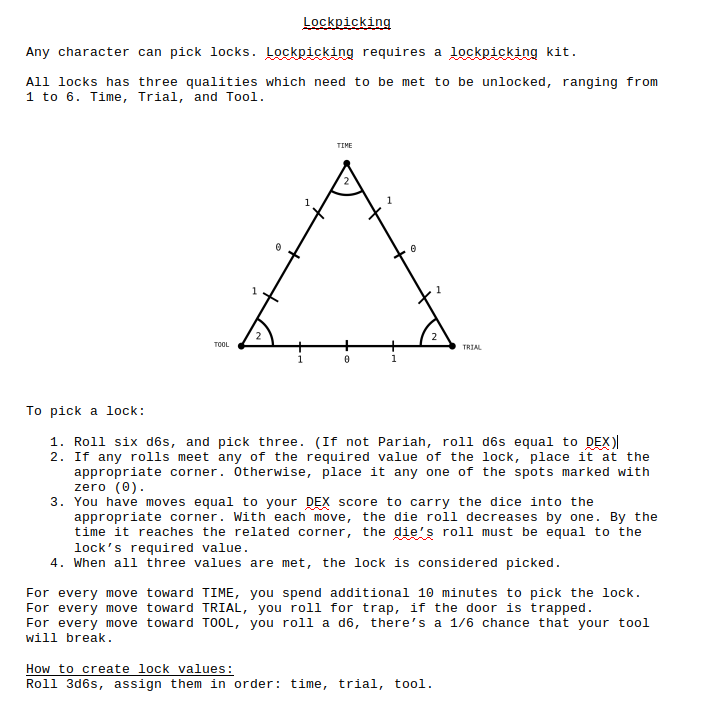Hexhunt 1.0 loading (taking longer than expected)
While I was working on the Dimyr adventure, for some reason, I've switched to 1.0 version of Hexhunt, which, to this date, I've still been working on. And this post is to let you know about some of the updates I've been shaping:
Classes
There are still four classes but this time, closer to the traditional fighting man, magic-user, thief, cleric. Warrior, Priest, Witch, and Pariah. Priest and Witch are using daybound and nightbound spells respectively. I've tried to make either class distinct, while both magic-users can cast spells, create scrolls and identify magic items, the spells they access to differ, and the magic items they create differ. Priests can create "blessed" items (assorted magical items), whereas Witches can create "enchanted" items (with power, drawback, recharge). Priests can create potions via Arcanum (requiring alchemy-like ingredients), whereas Witches can create potions via Herbalism (requiring herbs). Pariahs are much closer to thieves with skills like lockpick, climbing sheer surfaces, removing traps, etc.
Skills
For now I've been calling skills "knacks" (subject to change). And each class has access to different skills, in addition to free skills available for all. These are
- Free skills: survey, forage, fish, hunt and track, set traps, falconry (?), harvest
- Warrior skills: rage, shield block
- Priest skills: Spellcast (daybound), Arcanum, Brew posion, Bless, Spellbind, Reveal,
- Witch skills: Spellcast (daybound), Herbalism, Brew venom, Enchant, Spellbind, Reveal
- Pariah: Lockpick, Find/Remove traps, Pick pockets, Move silently, Climb, Hide, Detect, Backstab, Read, Disguise
And since Hexhunt is a solo-game, I have decided to make the use of skills more fun; i.e. not being limited to a single die roll, and more game-y. With a party, this might not be the best option but when you're all alone and want to play a game, it's a good thing that it is a bit more game-y. The standard for most skills is a roll of six d6s. Below you can see my draft for a sample skill of lockpicking:

I'm not sure if I should lock the skills to classes, yet, but it seems that that will be the best way to handle classes in terms of gameplay.
Combat
I've overhauled combat, removed quick combat so now all combats are tactical using grid. The number of actions available to a character are clearly laid out, depending if its engaged or unengaged. (Engaged characters can SHIFT, BASH, PARRY, STAND, SWING, DRAW, SPELLCAST, DISARM, GRAPPLE, DISENGAGE, for example.) In addition, weapon types are introduced (slashing, piercing, crushing) as well as different criticals (bloody, split, brutal, cripple, gut, etc.) While weapon types affect different armour differently, criticals work something like this:
- Brutal: breaks armour, rendering it ineffective and useless.
- Bloody: causes +1 damage for six rounds.
- Cripple: limits target’s movement to 1.
- Split: destroys the shield the target is wielding.
- Gut: causes 1d6 damage the next round.
Magic
Magic is now in three categories: daybound, nightbound and shadow. Daybound and Nightbound spells belong to their respective classes, whereas shadow magic is available only in the wilderness, and requires soulstone to be accessible. Over 70 shadow spells are listed, yet I don't know the final number yet. But if you're playing as a magic-user class, you'll have to get out there, and get those damn spells. I wanted magic to be tied closer to faith (and more dangerous) so there's a ZEAL score, ranging from 1 to 6, which, when reaches 0, causes a corruption in the magic-user as their magical powers are manifested in them through a soulstone bound to their souls. (Each failed attempt at casting a spell decreases zeal by 1. When zeal reaches zero, soulstone effects get activated.)
Terrain
I've divided the terrain into two basic categories, flat and rough: tundras, savannas, steppes, moors, meadows, mires, groves, wastes, badlands are all flat lands. Swamps, bogs, woods, lakes, forests, hills, mountains, jungles are all rough lands. It is harder to travel through rough terrain than flat terrain. And the regions are categorised into wilderness, borderlands, and civilization.
Time, movement, weight, encumbrance, etc.
- The main unit of time for exploration (overland travel) is the four-hour watch. And the main unit of time for delving (point of interest) is a moment which is 10 minutes long.
- There are basic rules for exploration (overland travel), and movement in points of interest (delving)
- The units of weight for easier encumbrance tracking are stone (2.5kg), and drachm (10gr, equal to a coin)
- Slot based encumbrance is adapted.
Factions
I've brewed the basic concept for faction play, which I hope will allow quests to emerge naturally for your character to take, for each game you are required to create at least three factions which dominate some portion of the hex grid; one aligned to order, one aligned to chaos and one which is neutral. I've wanted to make it easy to create and manage, as a side game, a second layer, so to speak, upon the character-level gameplay. While a single run of the deck takes one week, you'll play the faction-level game only once a month in-game time. There are three types of factions: martial, civil, and religious. Each will have the chance to hold an asset (for income), a warband (if things get bloody), and they will be running plots. This should be managable on a single character sheet beside your hexgrid map. Your character will be able to take up quests from factions, operating on a micro level.
Monsters
There are still demons, and they are the big bosses your character need to defeat. But I toned down the colourful (rainbow-like) fantasy element in monsters and limited to 36 different fantastical creatures, under six categories in total. I hope to explain them in detail along with a mini-monster-manual.
Task resolution
I've reworked the task resolution; and categorised it under two bids. (all names for mechanics subject to change).
- Core bids: roll a d6. Result must be lower than the related ability score.
- Perk bids: roll a d6. Result must be equal to, or lower than the related ability perk.
An example of core bid used in combat: To attack, pick a target and roll a d6, and add the STR perk if it’s melee, or DEX perk if it’s a ranged attack. Compare the result with the target’s DEX. If the result is higher, the attack registers a hit. Roll for damage.
Perk bids will be mostly used for saving throws.
So, I know this update leaves a lot to explain rather than clarify anything, but I still haven't written the rules clearly enough to share. This was just an update to let you know that I'm working on something.
Get Hexhunt
Hexhunt
Solo Fantasy Adventure Game
| Status | In development |
| Category | Physical game |
| Author | Utku |
| Genre | Role Playing |
| Tags | Dark Fantasy, Hexcrawl, nsr, OSR, Singleplayer, Solo RPG, Tabletop |
| Languages | English |
More posts
- Hexhunt beta is live (with Book III)!Jul 03, 2025
- Hexhunt Beta - Of Lairs & Wilderness (2/3)Apr 28, 2024
- Hexhunt Beta - Of Sword & Sorcery (1/3)Apr 13, 2024
- More lootAug 17, 2022
- Exploring the Dimyr RegionAug 13, 2022
- Quick Reference SheetAug 07, 2022
- Demons of DimyrAug 07, 2022
- Alpha Release:Aug 02, 2022

Leave a comment
Log in with itch.io to leave a comment.